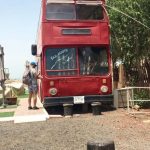Despite its crumbling buildings and forgotten lanes, Failaka Island, steeped in history, is one place you should head to for a quiet retreat. An added bonus – it is just 20 kilometers away from the hustle bustle of Kuwait City.
The island’s history dates back to the Dilmun civilization. It is believed that the Greeks lived on Failaka and called it Ikaros, after the mythological hero. Tourism, admittedly, is in its early stages. But despite its invisibility in guidebooks, Failaka is well worth the detour. Once a bustling town with over 2,000 residents, the island suffered heavy damage during the Iraqi invasion. Many of those who fled never returned.
The barren landscape is now dotted with dusty palm trees, abandoned homes, scores of burnt down buildings with graffiti on the walls, half-burnt vehicles and a scattering of armored tanks that stand defiantly as a grim reminder of the Gulf War.
On a lazy Friday afternoon, Failaka is eerily silent. The long stretch of dusty roads are largely empty as we make our way, armed with smartphones and cameras. We are a motley crew of artists on a ceramic tour planned by textile artist Ceyda Oskay. We are here to spend some time at a somewhat neglected pottery studio and then do some sightseeing around the island.
“Historically, ceramics have been made on the island at least since the time of Alexander the Great,” explains Ceyda. “I wanted to share the experience, so I organized a trip there with a great group of people.”
We take a ferry from Marina Crescent to Failaka, where we are met by a guide who takes us on a short bus tour of the island. The sea is a stunning blue, the sun strong and the sandy beaches inviting. But the stark beauty is marred by pockmarked buildings where the reality of war is plainly visible. Our first stop is the Hotel Ikarus. With its neatly manicured gardens, the food we are served is good and the Turkish coffee even better.
Within the vicinity of the Failaka Heritage Village, there is an array of things to do. There are parks for children to run amuck in, a swimming pool, paddle boats, camel rides, museums filled with artifacts and shops for you to buy handmade souvenirs. Head a little further from the Heritage Village, and you will spot a bullet-ridden NBK building.
“Failaka has developed so much as a destination since I last visited 12 years ago,” says Jassim Alnashmi, an artist and architect. “I am excited for the archaeology museum that is being built. I hope it gives the archaeological site the justice it deserves. The same could be done to the Kuwaiti buildings, to preserve the island’s history.”
“Failaka was such a short boat ride from Kuwait City, yet was such a different world once you landed on the island,” says Lesli Robertson, a recent Fulbright Specialist to Kuwait.
“I was not expecting to see such a large ceramics studio, complete with an enormous wood fire kiln. The studio created a great environment for our group to sit and get to know one another, finding common ground and sharing stories as we worked.”
“Outside of the Heritage Village was the remainder of the island, full of abandoned homes, schools, and city buildings. I found that the walks through these structures catalyzed my interest in the history of this place even more,” she adds.
“We hope to repeat the experience after the summer and add art-installation making to the trip, making a ‘Failaka Biennial’ around the themes of war, trauma, and reconciliation,” says Ceyda.
If you would like to plan a trip to Failaka that involves ceramic arts as well as a historical tour, get in touch with Ceyda Oskay at stationarymovement@yahoo.com.









